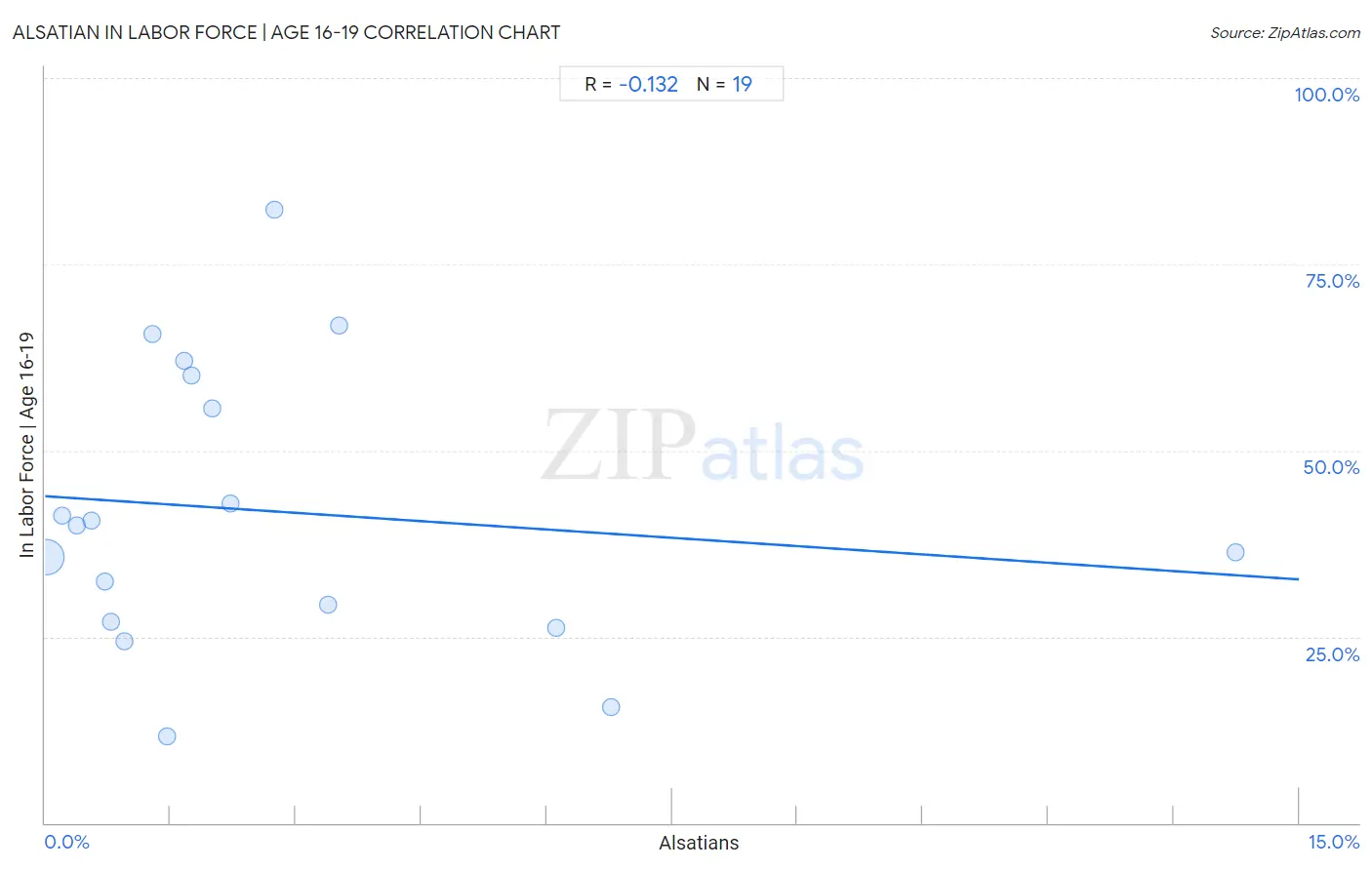Alsatian In Labor Force | Age 16-19
COMPARE
Alsatian
Select to Compare
In Labor Force | Age 16-19
Alsatian In Labor Force | Age 16-19
35.9%
IN LABOR FORCE | AGE 16-19
17.5/ 100
METRIC RATING
201st/ 347
METRIC RANK
Alsatian In Labor Force | Age 16-19 Correlation Chart
The statistical analysis conducted on geographies consisting of 82,608,203 people shows a poor negative correlation between the proportion of Alsatians and labor force participation rate among population between the ages 16 and 19 in the United States with a correlation coefficient (R) of -0.132 and weighted average of 35.9%. On average, for every 1% (one percent) increase in Alsatians within a typical geography, there is a decrease of 0.75% in labor force participation rate among population between the ages 16 and 19.

It is essential to understand that the correlation between the percentage of Alsatians and labor force participation rate among population between the ages 16 and 19 does not imply a direct cause-and-effect relationship. It remains uncertain whether the presence of Alsatians influences an upward or downward trend in the level of labor force participation rate among population between the ages 16 and 19 within an area, or if Alsatians simply ended up residing in those areas with higher or lower levels of labor force participation rate among population between the ages 16 and 19 due to other factors.
Demographics Similar to Alsatians by In Labor Force | Age 16-19
In terms of in labor force | age 16-19, the demographic groups most similar to Alsatians are Senegalese (35.9%, a difference of 0.010%), Immigrants from Nigeria (35.8%, a difference of 0.070%), Immigrants from Sweden (35.9%, a difference of 0.12%), Immigrants from Norway (35.9%, a difference of 0.19%), and Immigrants from Northern Africa (35.9%, a difference of 0.21%).
| Demographics | Rating | Rank | In Labor Force | Age 16-19 |
| Nigerians | 24.6 /100 | #194 | Fair 36.1% |
| Bolivians | 23.3 /100 | #195 | Fair 36.0% |
| Mexican American Indians | 21.1 /100 | #196 | Fair 36.0% |
| Immigrants from Serbia | 21.0 /100 | #197 | Fair 36.0% |
| Immigrants from Northern Africa | 19.9 /100 | #198 | Poor 35.9% |
| Immigrants from Norway | 19.8 /100 | #199 | Poor 35.9% |
| Immigrants from Sweden | 18.8 /100 | #200 | Poor 35.9% |
| Alsatians | 17.5 /100 | #201 | Poor 35.9% |
| Senegalese | 17.4 /100 | #202 | Poor 35.9% |
| Immigrants from Nigeria | 16.8 /100 | #203 | Poor 35.8% |
| Immigrants from Albania | 15.0 /100 | #204 | Poor 35.8% |
| South American Indians | 14.6 /100 | #205 | Poor 35.8% |
| Chileans | 14.6 /100 | #206 | Poor 35.8% |
| Immigrants from Eastern Europe | 14.5 /100 | #207 | Poor 35.8% |
| Koreans | 13.3 /100 | #208 | Poor 35.7% |
Alsatian In Labor Force | Age 16-19 Correlation Summary
| Measurement | Alsatian Data | In Labor Force | Age 16-19 Data |
| Minimum | 0.016% | 11.6% |
| Maximum | 14.2% | 82.4% |
| Range | 14.2% | 70.8% |
| Mean | 2.7% | 41.9% |
| Median | 1.7% | 40.0% |
| Interquartile 25% (IQ1) | 0.72% | 27.0% |
| Interquartile 75% (IQ3) | 3.4% | 60.0% |
| Interquartile Range (IQR) | 2.7% | 33.0% |
| Standard Deviation (Sample) | 3.4% | 18.9% |
| Standard Deviation (Population) | 3.3% | 18.4% |
Correlation Details
| Alsatian Percentile | Sample Size | In Labor Force | Age 16-19 |
[ 0.0% - 0.5% ] 0.016% | 81,369,991 | 35.6% |
[ 0.0% - 0.5% ] 0.20% | 913,144 | 41.3% |
[ 0.0% - 0.5% ] 0.38% | 111,821 | 40.0% |
[ 0.5% - 1.0% ] 0.56% | 109,505 | 40.6% |
[ 0.5% - 1.0% ] 0.72% | 32,091 | 32.5% |
[ 0.5% - 1.0% ] 0.79% | 36,436 | 27.0% |
[ 0.5% - 1.0% ] 0.95% | 5,784 | 24.4% |
[ 1.0% - 1.5% ] 1.29% | 3,408 | 65.7% |
[ 1.0% - 1.5% ] 1.46% | 1,648 | 11.6% |
[ 1.5% - 2.0% ] 1.67% | 4,555 | 62.0% |
[ 1.5% - 2.0% ] 1.75% | 1,604 | 60.0% |
[ 1.5% - 2.0% ] 1.99% | 502 | 55.6% |
[ 2.0% - 2.5% ] 2.23% | 1,573 | 42.9% |
[ 2.5% - 3.0% ] 2.74% | 547 | 82.4% |
[ 3.0% - 3.5% ] 3.39% | 827 | 29.3% |
[ 3.5% - 4.0% ] 3.52% | 1,848 | 66.7% |
[ 6.0% - 6.5% ] 6.11% | 2,994 | 26.2% |
[ 6.5% - 7.0% ] 6.77% | 9,202 | 15.6% |
[ 14.0% - 14.5% ] 14.25% | 723 | 36.4% |